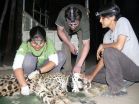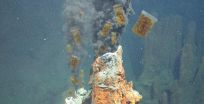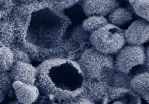(Press-News.org) Study says leopards stay surprisingly close to homes
Leopard home range around humans can be comparable to world's best protected areas
Article available from PLOS ONE
NEW YORK (November 21, 2014) - In the first-ever GPS-based study of leopards in India, led by WCS and partners has delved into the secret lives of these big cats, and recorded their strategies to thrive in human-dominated areas.
The study concludes that leopards in human areas are not always 'stray' or 'conflict' animals but residents, potentially requiring policy makers to rethink India's leopard-management strategies.
The study was a collaboration of Vidya Athreya of WCS India (Wildlife Conservation Society), scientists from Norway (Morten Odden from Hedmark University College and John Linnell from Norwegian Institute for Nature Research), Sandeep Rattan of the Himachal Pradesh Forest Department, Maharashtra Forest Department and Asian Nature Conservation Foundation. Their findings were published recently in the journal PLOS ONE in the article "Adaptable Neighbours: Movement patterns of GPS-collared leopards in human-dominated landscapes in India."
Five leopards (two males and three females) perceived as "problem animals" and captured from human-dominated areas despite no predatory attack on people, were radio-collared for the study. Two were translocated and released more than 50 km (31 miles) away, while the remaining three were released near the site of capture.
The scientists monitored the animals' activities from the time of release, for up to a year, recording their behavior - including strategies they adopt to avoid direct contact with people.
The findings
Immediately after release, the two translocated animals moved away 89 km (55 miles) and 45 km respectively (28 miles) from the release sites.
Said co-author Vidya Athreya of WCS India: "This indicated futility of translocation as a management strategy; this could have in fact, aggravated the conflict, as these animals passed through highly-human dominated (even industrial) areas," contended the scientists.
However, the animals applied tactics to avoid encountering people, despite dependence on their resources.
Firstly, the animals mostly moved at night, which timed perfectly with low human activity. They also spent more time closer to homes ( END
Next-door leopards: First GPS-collar study reveals how leopards live with people
Study says leopards stay surprisingly close to homes
2014-11-21
ELSE PRESS RELEASES FROM THIS DATE:
Obesity-attributable absenteeism among US workers costs the nation more than $8 billion annually
2014-11-21
November 21, 2014 -- A study conducted by researchers at Columbia University's Mailman School of Public Health shows that obesity costs the U.S. $8.65 billion per year as a result of absenteeism in the workplace --more than 9% of all absenteeism costs. The consequences of obesity among the working population go beyond healthcare and create a financial challenge not only for the nation but for individual states as well. Findings are published online in the Journal of Occupational and Environmental Medicine.
The study is the first to provide state-level estimates of obesity-attributable ...
Immune checkpoint inhibitors may work in brain cancers
2014-11-21
Lugano/Geneva, Switzerland, 21 November 2014 - New evidence that immune checkpoint inhibitors may work in glioblastoma and brain metastases was presented today by Dr Anna Sophie Berghoff at the ESMO Symposium on Immuno-Oncology 2014 in Geneva, Switzerland.
The novel research shows that brain metastases have dense concentrations of tumour infiltrating lymphocytes, providing an immunoactive environment. Moreover, both primary and secondary brain cancers often exhibit high expression of the immunosuppressive factor programmed cell death ligand 1 (PDL1), which can be inhibited ...
Life's extremists may be an untapped source of antibacterial drugs
2014-11-21
One of the most mysterious forms of life may turn out to be a rich and untapped source of antibacterial drugs.
The mysterious life form is Archaea, a family of single-celled organisms that thrive in environments like boiling hydrothermal pools and smoking deep sea vents which are too extreme for most other species to survive.
"It is the first discovery of a functional antibacterial gene in Archaea," said Seth Bordenstein, the associate professor of biological sciences at Vanderbilt University who directed the study, "You can't overstate the significance of the antibiotic ...
Research examines an emerging issue: Treatment of transgendered prison populations
2014-11-21
Prison policies vary on treating transgendered inmates, which could put inmates and institutions at risk. Gina Gibbs, a University of Cincinnati criminal justice doctoral student, will present a synopsis of the legal issues posed by such inmates at the annual meeting of the American Society of Criminology. The national conference runs from Nov. 19-22 in San Francisco.
At the center of the debate are Eighth Amendment protections against cruel and unusual punishment, widely varying policies on the treatment of transgendered populations and, Gibbs says, court crackdowns ...
Not all baseball stars treated equally in TV steroid coverage, says study of network news
2014-11-21
CHAMPAIGN, Ill. -- Retired baseball stars Barry Bonds, Mark McGwire and Rafael Palmeiro each had Hall of Fame-worthy numbers, each hitting more than 500 home runs.
All three also were tarred by allegations of steroid use.
Their stories, however, received very different treatment over 12 years of national television news coverage, says University of Illinois professor Brian Quick, lead author on a paper about that coverage and its effects, published online Nov. 20 by the journal Communication Research.
"We found that Bonds received more than twice as many negative stories ...
When shareholders exacerbate their own banks' crisis
2014-11-21
This news release is available in German. One lesson that policymakers and financial regulators have drawn from the financial market crisis is that banks need to be backed by more equity. But banks have found it hard to increase their core capital positions - in other words, the equity available to them long-term. Since 2009, this has led European banks to increasingly deploy an instrument that allows them to convert debt into equity in times of need: contingent convertible bonds, also known as CoCo bonds. Banks issue these bonds at fixed interest rates - as is normal ...
A coating that protects against heat and oxidation
2014-11-21
Gases don't conduct heat as well as solids do. Cellular or aerated concretes take advantage of this effect, which experts call "gas-phase insulation". The heat barrier is achieved by air encased in the cavities of the concrete. But gas-phase insulation has far greater potential than keeping our homes warm. It can also be used to protect turbine engine and waste incinerator components when subjected to intense heat. All you need to do is transfer this effect to a coating that is just a few hundred micrometers thick.
Temperature differences of over 400 degrees Celsius
Scientists ...
Type 2 diabetes: Added benefit of canagliflozin plus metformin is not proven
2014-11-21
The fixed combination of canagliflozin with metformin (trade name: Vokanamet) has been approved since April 2014 for adults with type 2 diabetes mellitus in whom diet and exercise do not provide adequate glycaemic control. The German Institute for Quality and Efficiency in Health Care (IQWiG) now examined in a dossier assessment whether the new drug combination offers an added benefit over the appropriate comparator therapy. No such added benefit can be derived from the dossier, however, because the manufacturer did not present any suitable data for any of the possible ...
Possibilities for personalized vaccines revealed at ESMO symposium
2014-11-21
Lugano/Geneva, Switzerland, 21 November 2014 - The possibilities for personalised vaccines in all types of cancer are revealed today in a lecture from Dr Harpreet Singh at the ESMO Symposium on Immuno-Oncology 2014 in Geneva, Switzerland.
"One of the biggest hurdles in cancer immunotherapy is the discovery of appropriate cancer targets that can be recognised by T-cells," said Singh, who is scientific coordinator of the EU-funded GAPVAC phase I trial which is testing personalised vaccines in glioblastoma, the most common and aggressive brain cancer. "In the GAPVAC trial ...
New model of follow up for breast cancer patients
2014-11-21
Public health researchers from the University of Adelaide have evaluated international breast cancer guidelines, finding that there is potential to improve surveillance of breast cancer survivors from both a patient and health system perspective.
International guidelines recommend annual follow-up mammograms for every woman after treatment for early breast cancer, regardless of the risk of her cancer returning. There is also no strong evidence to support annual mammography compared with other possible mammography schedules.
In a paper published in the journal Value ...
LAST 30 PRESS RELEASES:
Orthopedics can play critical role in identifying intimate partner violence
Worms as particle sweepers
Second spider-parasitic mite described in Brazil
January 2026 issues of APA journals feature new research on autism, pediatric anxiety, psychedelic therapy, suicide prevention and more
Private equity acquired more than 500 autism centers over the past decade, new study shows
New cervical cancer screening guidelines from the US Department of Health and Human Services
Estimated burden of COVID-19 illnesses, medical visits, hospitalizations, and deaths in the US from October 2022 to September 2024
Smartphone use during school hours by US youth
Food insecurity and adverse social conditions tied to increased risk of long COVID in children
Earliest, hottest galaxy cluster gas on record could change our cosmological models
Greenland’s Prudhoe Dome ice cap was completely gone only 7,000 years ago, first GreenDrill study finds
Scientific validity of blue zones longevity research confirmed
Injectable breast ‘implant’ offers alternative to traditional surgeries
Neuroscientists devise formulas to measure multilingualism
New prostate cancer trial seeks to reduce toxicity without sacrificing efficacy
Geometry shapes life
A CRISPR screen reveals many previously unrecognized genes required for brain development and a new neurodevelopmental disorder
Hot flush treatment has anti-breast cancer activity, study finds
Securing AI systems against growing cybersecurity threats
Longest observation of an active solar region
Why nail-biting, procrastination and other self-sabotaging behaviors are rooted in survival instincts
Regional variations in mechanical properties of porcine leptomeninges
Artificial empathy in therapy and healthcare: advancements in interpersonal interaction technologies
Why some brains switch gears more efficiently than others
UVA’s Jundong Li wins ICDM’S 2025 Tao Li Award for data mining, machine learning
UVA’s low-power, high-performance computer power player Mircea Stan earns National Academy of Inventors fellowship
Not playing by the rules: USU researcher explores filamentous algae dynamics in rivers
Do our body clocks influence our risk of dementia?
Anthropologists offer new evidence of bipedalism in long-debated fossil discovery
Safer receipt paper from wood
[Press-News.org] Next-door leopards: First GPS-collar study reveals how leopards live with peopleStudy says leopards stay surprisingly close to homes




